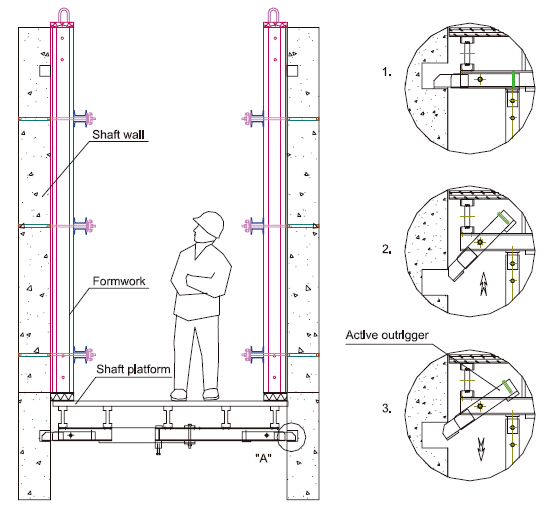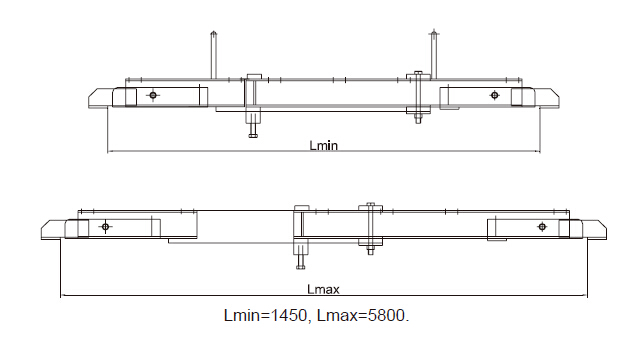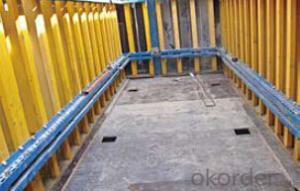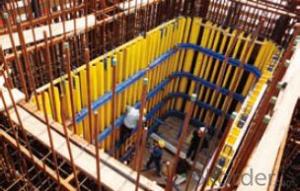Shaft Platform S40 Systems for Formwork and Scaffolding
- Loading Port:
- Tianjin
- Payment Terms:
- TT OR LC
- Min Order Qty:
- 50 m²
- Supply Capability:
- 1000 m²/month
OKorder Service Pledge
Quality Product, Order Online Tracking, Timely Delivery
OKorder Financial Service
Credit Rating, Credit Services, Credit Purchasing
You Might Also Like
Shaft Platform
As operating platform, the shaft platform is mainly used in the concrete pouring of elevator shaft,
equipment shaft, stair shaft of high-rise building and so on.
Characteristics:
◆ The length of shaft beam is adjustable.
◆ Flexible structure makes lifting easier.


- Q:Can steel formwork be used for post-tensioned concrete structures?
- Post-tensioned concrete structures can utilize steel formwork, which is a versatile and durable material capable of withstanding the forces created during the post-tensioning process. The steel formwork functions as a rigid and stable support, allowing for precise shaping and positioning of the post-tensioned tendons. There are several advantages to using steel formwork for post-tensioned concrete structures. Firstly, it aids in achieving the desired shape and dimensions by providing a robust framework. This is crucial as the internal forces generated by the tendons can exert significant pressure on the formwork. Secondly, steel formwork enables easy and efficient installation of the post-tensioned tendons. It can be specifically designed to accommodate the tendons and their anchorages, ensuring proper placement and alignment. Accurate positioning of the tendons is vital for achieving the desired structural performance. Furthermore, steel formwork offers excellent reusability and durability. It can endure multiple concrete pourings and can be dismantled and reassembled for future use. This makes it a cost-effective option for post-tensioned concrete structures, particularly those with repetitive elements. However, it is crucial to note that design and construction of steel formwork for post-tensioned concrete structures should be undertaken by experienced professionals. This ensures the formwork can withstand the forces generated during the post-tensioning process and provides the necessary support and alignment for the tendons. Adequate attention must also be given to factors such as formwork strength, rigidity, and anchorage points to ensure a successful post-tensioning operation. In conclusion, steel formwork can be effectively employed in post-tensioned concrete structures, provided it is appropriately designed and constructed to meet the project's specific requirements.
- Q:Can steel formwork be used for architectural features?
- Yes, steel formwork can definitely be used for architectural features. Steel formwork is a versatile and durable construction material that is commonly used in various architectural applications. Its strength and rigidity make it suitable for creating complex and intricate architectural features such as columns, arches, beams, and decorative facades. Steel formwork provides excellent support and stability during the concrete pouring process, ensuring that the desired shape and design of architectural features are accurately achieved. Its high load-bearing capacity allows for the creation of large-scale architectural elements that might not be possible with other types of formwork materials. In addition to its structural benefits, steel formwork offers several advantages in terms of aesthetics. It can be easily molded and shaped to create unique and eye-catching architectural features. Steel formwork can also be customized with various surface finishes, textures, and patterns, providing architects with a wide range of design options to incorporate into their projects. Furthermore, steel formwork is highly reusable, making it a sustainable choice for architectural applications. Its durability allows for multiple uses, reducing waste and construction costs. This makes it a preferred choice for architects and contractors who value sustainability and cost-efficiency. Overall, steel formwork is an excellent choice for creating architectural features due to its strength, versatility, and aesthetic possibilities. Its ability to support complex designs and its sustainable nature make it a popular option in the construction industry.
- Q:How does steel formwork contribute to easier formwork removal?
- Steel formwork contributes to easier formwork removal in several ways. Firstly, steel formwork is known for its strength and durability, allowing it to withstand the pressure exerted by the poured concrete. This means that steel formwork is less likely to warp or deform during the curing process, resulting in a more stable structure and easier removal. Additionally, steel formwork is typically designed with smooth surfaces and tight joints, which prevents the concrete from sticking to the formwork. As a result, when it comes time to remove the formwork, the concrete can be easily separated from the steel surface, minimizing the risk of damage to the concrete and making the removal process quicker and more efficient. Furthermore, steel formwork often incorporates various release agents or coatings that further facilitate the easy removal of the formwork. These agents act as a barrier between the concrete and the steel, reducing adhesion and allowing for smooth separation. Overall, the use of steel formwork provides a reliable and efficient solution for formwork removal, ensuring that the process is easier, faster, and more cost-effective.
- Q:Types of building templates? What is the clear water template
- 1 plastic template: at present, there are many companies to develop a variety of plastic template, such as hard template, reinforced plastic wood plastic composite template, GMT plastic, plastic and plastic floor template template template system, reduce wood cutting, replacing the traditional technology with new technology, I believe the future will be used widely used in building materials industry.
- Q:Is steel formwork suitable for high-rise construction?
- Yes, steel formwork is suitable for high-rise construction. Steel formwork offers several advantages for high-rise construction projects. Firstly, steel formwork is strong and durable, capable of withstanding the high pressures and loads that are associated with constructing tall buildings. This ensures the safety and stability of the structure during the construction process. Secondly, steel formwork is highly versatile and can be easily customized to meet the specific requirements of high-rise construction. It can be designed and fabricated into various shapes and sizes, allowing for flexibility in creating different structural elements such as walls, columns, and slabs. This adaptability enables efficient construction and minimizes the need for extensive modifications or adjustments. Furthermore, steel formwork is reusable, which makes it cost-effective for high-rise construction projects. The ability to reuse steel formwork reduces the overall construction costs as it eliminates the need for constant purchase or fabrication of new formwork materials. This also contributes to a more sustainable construction practice by minimizing waste and promoting resource efficiency. Additionally, steel formwork provides a smooth and even surface finish, ensuring high-quality construction for high-rise buildings. The smooth finish reduces the need for extensive plastering or finishing works, saving time and resources during the construction process. In conclusion, steel formwork is indeed suitable for high-rise construction due to its strength, versatility, reusability, and ability to provide a smooth finish. These qualities make it an ideal choice for efficiently and effectively constructing tall buildings.
- Q:Can steel formwork be used in areas with high seismic vulnerability?
- Yes, steel formwork can be used in areas with high seismic vulnerability. Steel is a strong and durable material that can withstand the forces and vibrations caused by earthquakes. It provides stability and structural integrity to the formwork system, making it suitable for use in seismic-prone regions. Additionally, steel formwork can be designed and reinforced to meet the specific requirements and regulations of the area, ensuring its suitability for use in high seismic vulnerability zones.
- Q:What are the different types of connectors used with steel formwork?
- To ensure stability and proper alignment, steel formwork can utilize various types of connectors. These connectors are designed to securely join the formwork components and establish a reliable connection. 1. Wedge connectors, commonly employed, consist of a wedge-shaped piece that fits into a slot or hole in the formwork. By tightening the wedge, a strong and secure connection is created. Due to their ease of installation and removal, wedge connectors are favored in steel formwork systems. 2. Pin connectors are typically used to connect two formwork panels together. They involve inserting a pin through holes in the formwork panels and securing it with a locking mechanism. Pin connectors are straightforward and effective, providing stability between panels. 3. Bolt connectors are suitable for heavy-duty and permanent connections. These connectors require bolts to be inserted through pre-drilled holes in the formwork components and tightened with nuts. Bolt connectors offer high strength and stability, making them ideal for larger formwork systems or when dealing with heavier loads. 4. Clamp connectors join formwork components by clamping them with a fastening mechanism. These connectors usually consist of metal plates or brackets that are tightened around the formwork components, ensuring a secure connection. Clamp connectors are versatile and can be used in various formwork applications. 5. Magnetic connectors, a newer type of connector, utilize magnets to join formwork components. Typically made of steel, these connectors contain strong magnets that attract to each other, creating a secure connection. Magnetic connectors are easy to install and remove, eliminating the need for additional tools or fasteners. Overall, the choice of connector for steel formwork depends on project-specific requirements, such as formwork system size, complexity, load-bearing capacity, and desired ease of installation and removal. It is crucial to select connectors that are compatible with the formwork components and provide the necessary strength and stability for the construction process.
- Q:How does steel formwork handle different weather conditions?
- Known for its durability and resistance to various weather conditions, steel formwork possesses the capacity to withstand extreme temperatures, heavy rain, strong winds, and even snow. One of the primary benefits of steel formwork lies in its ability to endure high temperatures without deformity or loss of structural integrity. This quality renders it suitable for utilization in hot climates where temperatures can soar. Furthermore, steel formwork does not readily absorb heat, enabling it to remain cool to the touch even when exposed to direct sunlight. Moreover, steel formwork exhibits exceptional resistance to heavy rain and water exposure. It does not succumb to rot, warping, or degradation when in contact with water, making it an ideal choice for regions with abundant rainfall or high humidity levels. Furthermore, steel does not readily absorb moisture, effectively preventing the growth of mold or mildew, which can be problematic with other formwork materials. Another advantage of steel formwork lies in its resilience against strong winds. The inherent strength and rigidity of steel render it highly resistant to wind loads. This attribute becomes particularly crucial in areas prone to hurricanes, cyclones, or forceful gusts of wind. Steel formwork provides stability and ensures the structure remains intact even during severe weather conditions. Additionally, steel formwork can effectively handle snow and cold temperatures. It does not crack or become brittle when exposed to freezing temperatures, making it a suitable choice for cold climates. The strength and durability of steel formwork guarantee that it can support the weight of accumulated snow without suffering structural damage. In conclusion, steel formwork stands as a dependable and robust solution capable of effectively managing diverse weather conditions. Its ability to withstand extreme temperatures, heavy rain, strong winds, and snow has contributed to its widespread use in construction projects worldwide.
- Q:How does steel formwork prevent concrete shrinkage and cracking?
- The use of steel formwork is essential in preventing concrete shrinkage and cracking. By offering robust and rigid support during the curing process, it ensures that the concrete retains its shape and hardens properly. Acting as a mold, the steel formwork securely holds the concrete in place, preventing any shrinkage or cracking as it dries. Concrete shrinkage and cracking are primarily caused by the loss of moisture during curing. As the water evaporates from the concrete, it causes the material to shrink, potentially leading to cracks if not adequately supported. To prevent this shrinkage, steel formwork provides a tight enclosure for the concrete, ensuring that it retains its moisture and doesn't dry out too quickly. This controlled drying process allows for even curing, minimizing the risk of shrinkage and cracking. Moreover, steel formwork provides stability and support to the concrete, preventing any movement or shifting as it hardens. This stability helps distribute forces and stresses evenly, reducing the likelihood of cracking or structural failure. Furthermore, the smooth and rigid surface of steel formwork contributes to achieving a high-quality finish on the concrete. This eliminates any irregularities or imperfections that may weaken the structure or make it more susceptible to cracking. In conclusion, steel formwork is vital in preventing concrete shrinkage and cracking by offering support, stability, and moisture retention during the curing process. Its strong and rigid structure ensures the integrity of the concrete and enhances its durability, reducing the risk of structural issues.
- Q:How does steel formwork affect the overall sound insulation of a structure?
- The overall sound insulation of a structure can be significantly influenced by steel formwork. Steel formwork, due to its dense and rigid nature, tends to transmit sound vibrations more efficiently compared to materials like wood or plastic. This means that extensive use of steel formwork in a building's construction can potentially reduce its sound insulation capabilities. The transmission of sound through steel formwork primarily occurs through three mechanisms: airborne sound, impact sound, and structure-borne sound. Airborne sound refers to sound waves traveling through the air and being transmitted through the steel formwork. Impact sound occurs when a sound wave hits the steel surface, causing it to vibrate and transmit the sound further. Structure-borne sound refers to vibrations traveling through the steel formwork and being transmitted to other parts of the building. To mitigate the negative impact of steel formwork on sound insulation, various measures can be taken. One approach is to incorporate additional sound-absorbing materials, such as acoustic panels or insulation, on the interior surfaces of the structure. These materials can help reduce the transmission of airborne sound waves and dampen the vibrations caused by impact or structure-borne sound. Additionally, proper sealing and jointing of the formwork can minimize sound leakage through gaps or cracks. It is important to recognize that the overall sound insulation of a structure is not solely determined by the formwork material. Other factors, such as wall thickness, insulation type, and the design of windows and doors, also play a crucial role. Therefore, while steel formwork may have a negative impact on sound insulation, it is possible to compensate for this by implementing appropriate acoustic design strategies and integrating soundproofing techniques throughout the building's construction process.
1. Manufacturer Overview |
|
|---|---|
| Location | |
| Year Established | |
| Annual Output Value | |
| Main Markets | |
| Company Certifications | |
2. Manufacturer Certificates |
|
|---|---|
| a) Certification Name | |
| Range | |
| Reference | |
| Validity Period | |
3. Manufacturer Capability |
|
|---|---|
| a)Trade Capacity | |
| Nearest Port | |
| Export Percentage | |
| No.of Employees in Trade Department | |
| Language Spoken: | |
| b)Factory Information | |
| Factory Size: | |
| No. of Production Lines | |
| Contract Manufacturing | |
| Product Price Range | |
Send your message to us
Shaft Platform S40 Systems for Formwork and Scaffolding
- Loading Port:
- Tianjin
- Payment Terms:
- TT OR LC
- Min Order Qty:
- 50 m²
- Supply Capability:
- 1000 m²/month
OKorder Service Pledge
Quality Product, Order Online Tracking, Timely Delivery
OKorder Financial Service
Credit Rating, Credit Services, Credit Purchasing
Similar products
New products
Hot products
Related keywords























